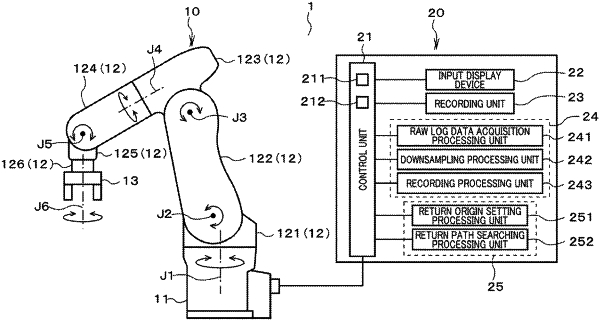| CPC B25J 9/1664 (2013.01) [G05B 19/4155 (2013.01); G05B 2219/40269 (2013.01)] | 11 Claims |

|
1. A method of searching a return path of a robot to an origin thereof, wherein the return path is for returning a movable arm of the robot from a current position to the origin on a trajectory of motions of the movable arm of the robot, based on operation log data of the robot which are recorded in a recording unit, the method being performed by a processor that executes a computer program that causes the processor to perform the method which comprises steps of:
a return necessity determining step determining whether it is necessary to return the arm from the current position to the origin;
a straight-line portion determining step determining whether there is a trajectory portion regarded as being a straight line on a motion trajectory of the arm, based on the operation log data recorded in the recording unit at a time when the return necessity determining step determines that the arm is necessary to be returned to the origin, the motion trajectory being provided at or before the return necessity determination;
a decimating step decimating operation log data of a node which are present between two nodes which are at both ends of the trajectory portion regarded as being a straight line in a time-series space produced at every constant timing, when the straight-line portion determining step determines that there is the trajectory portion regarded as being the straight line on the motion trajectory of the arm; and
a calculating step calculating the return path along which the arm returns to the origin, based on remaining operation log data which are left in the operation data log after the decimating, wherein
the calculating step repeatedly performs decimation processing for three operation log data D(R; an initial value of R represents the return origin), D(R+X; X is a natural number and an initial value is 1) and D(R+X+1)
by deleting the operation log data D(R+X) when an angle formed between a first vector and a second vector for each of a position and a posture of an end effector of the robot is greater than a threshold, the first vector being determined by the operation log data D(R+X) and the operation log data D(R) and the second vector being determined by the operation log data D(R+X) and the operation log data D(R+X+1), and comparing the angle formed between the first vector and the second vector with the threshold after the variable X is incremented, and
by leaving the operation log data D(R+X) when the angle is smaller than or equal to the threshold, and comparing the angle formed between the first vector and the second vector with the threshold after the D(R+X) is set to a next operation log data D(R) and the variable X is set to an initial value “1”, and
the calculating step stops the decimation processing when the operation log data D(R+X+1) reaches the current position.
|